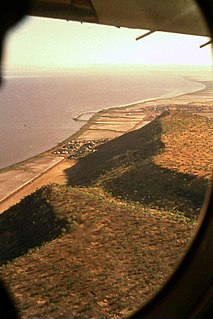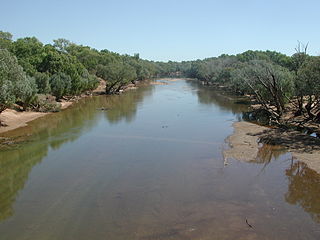Related Research Articles

The Kimberley is the northernmost of the nine regions of Western Australia. It is bordered on the west by the Indian Ocean, on the north by the Timor Sea, on the south by the Great Sandy and Tanami deserts in the region of the Pilbara, and on the east by the Northern Territory.

The Ord River is a 651-kilometre long (405 mi) river in the Kimberley region of Western Australia. The river's catchment covers 55,100 square kilometres (21,274 sq mi).

The Fitzroy River is located in the West Kimberley region of Western Australia. It has 20 tributaries and its catchment occupies an area of 93,829 square kilometres (36,228 sq mi), within the Canning Basin and the Timor Sea drainage division.

Wyndham is the northernmost town in the Kimberley region of Western Australia, located on the Great Northern Highway, 2,210 kilometres (1,373 mi) northeast of Perth. It was established in 1886 to service a new goldfield at Halls Creek, and it is now a port and service centre for the east Kimberley with a population of 780. Aboriginal and Torres Strait Islander people make up 54% of the population. Wyndham comprises two areas - the original town site at Wyndham Port situated on Cambridge Gulf, and 5 kilometres (3.1 mi) by road to the south, the Three Mile area with the residential and shopping area for the port, also founded in 1886. Wyndham is part of the Shire of Wyndham-East Kimberley.

The Wunaamin Miliwundi Ranges, formerly known as the King Leopold Ranges between 1879 and 2020, are a range of hills in the western Kimberley region of Western Australia.

The land border of the State of Western Australia (WA) bisects mainland Australia, nominally along 129th meridian east longitude. The border divides WA from the Northern Territory (NT) and South Australia (SA).
Noonkanbah Station is a pastoral lease, both a cattle and sheep station, on the Fitzroy River between Camballin and Fitzroy Crossing in the south central Kimberley region of Western Australia.

Cambridge Gulf is a gulf on the north coast of the Kimberley region of Western Australia. Many rivers flow into the gulf, including the Ord River, Pentecost River, Durack River, King River and the Forrest River, making the environment an estuarine one.

Pentecost River is a river in the Kimberley region of Western Australia.
Durack River is a river in the Kimberley region of Western Australia.

The Chamberlain River is a river in the Kimberley region of Western Australia.

The King George River is a perennial river located in the Kimberley region of Western Australia.

Wave Hill Station, most commonly referred to as Wave Hill, is a pastoral lease in the Northern Territory operating as a cattle station. The property is best known as the scene of the Wave Hill walk-off, a strike by Indigenous Australian workers for better pay and conditions, which in turn was an important influence on Aboriginal land rights in Australia.

Yeeda Station is a pastoral lease that operates as a cattle station in the Kimberley region of Western Australia.
Kimberley Downs Station, commonly referred to as Kimberley Downs, is a pastoral lease that operates as a cattle station in Western Australia.

Alice Downs Station is a pastoral lease that operates as a cattle station in Western Australia. As of March 2022 it is one of four stations known as the Springvale Aggregation, owned by Harvest Road.

In 1932, pilot Hans Bertram and mechanic Adolph Klausmann were rescued while attempting to circumnavigate the world in a Junkers W 33 seaplane. After departing Koepang, Dutch Timor, they endured a storm in the Timor Sea on 15 May and were forced to land in a remote coastal area of the Kimberley region in northern Western Australia. The stranded men spent almost six weeks severely deprived of food and water and were close to death when they were rescued by a group of local Aboriginal fishermen on 22 June.

Moola Bulla Station is a pastoral lease that operates as a cattle station in the Kimberley region of Western Australia. It is approximately 20 kilometres (12 mi) west of Halls Creek and 150 kilometres (93 mi) south of Warmun, and occupies an area of 6,600 square kilometres (2,548 sq mi). It bisects the watershed of the Fitzroy River and Ord Rivers.
Charles Price Conigrave (1882–1961) was a West Australian zoölogist, author and explorer. He led the Kimberley Exploring Expedition of 1911, making collections of flora and fauna. and mapping the region between Cambridge Gulf and Napier Broome Bay. Conigrave included photographs of Aboriginal art in his reports, which were published in contemporary newspapers.
References
- ↑ "Bonzle Digital Atlas – Map of Berkeley River". 2012. Retrieved 29 April 2012.
- ↑ "Modelled seabed response to possible climate change scenarios over the next 50 years in the Australian Northwest" (PDF). CSIRO. 1 March 2008. Archived from the original (PDF) on 7 September 2013. Retrieved 16 January 2014.
- ↑ "Letters Kimberley coast". The Sydney Morning Herald . New South Wales: National Library of Australia. 26 May 1937. p. 8. Retrieved 23 January 2012.
- ↑ "[No heading]". Western Mail . Perth: National Library of Australia. 13 December 1912. p. 40. Retrieved 25 January 2012.
- ↑ "Ausanthrop – Australian Aboriginal tribal database". 2012. Archived from the original on 29 November 2014. Retrieved 29 April 2012.
- ↑ "History of river names – B". Western Australian Land Information Authority. Retrieved 29 April 2012.
Coordinates: 14°21′09″S127°47′20″E / 14.35250°S 127.78889°E